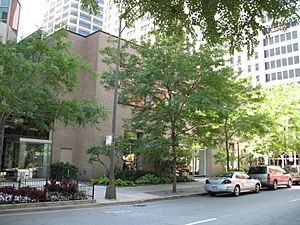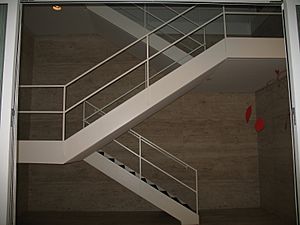Arts Club of Chicago facts for kids
 |
|
| Lua error in Module:Location_map at line 420: attempt to index field 'wikibase' (a nil value). | |
| Established | 1916 (current location since April 4, 1997) |
|---|---|
| Location | 201 E. Ontario Street, Chicago, Illinois 60611 United States |
The Arts Club of Chicago is a special place in Chicago that is both a private club and a public art gallery. It is located near the famous Magnificent Mile and shows contemporary art from all over the world. Contemporary art is art made in our time.
The club was started in 1916. At the time, many people in Chicago were not used to modern art. The club's founders wanted to show the city new and exciting ideas in art, music, and writing. From the very beginning, the Arts Club supported Modernist art, which was a new and different style.
The club is famous for hosting the first-ever show in the United States for the artist Pablo Picasso. It has also shown works by many other important artists.
In 1997, the club moved to its current building. This caused some debate because a famous interior designed by architect Ludwig Mies van der Rohe had to be taken down. However, the club saved the beautiful central staircase and moved it to the new, larger building.
Contents
What is the Club's Mission?
The club's first mission was "to encourage higher standards of art, maintain galleries for that purpose, and to promote the mutual acquaintance of art lovers and art workers." This means they wanted to support great art, have a place to show it, and bring together people who love and create art.
The founders created the club after a big art show called the Armory Show came to Chicago in 1913. Many people who saw the show didn't understand the new styles of art. The Arts Club wanted to help people in Chicago see and appreciate these new forms of art.
The club has always been a place for culture "in the making." It serves as a key spot in Chicago for showing work by the avant-garde, which means artists who are trying new and experimental ideas. Instead of showing exhibitions that travel from other museums, the Arts Club creates its own unique shows.
History of the Club

The Arts Club of Chicago was founded in 1916. At first, it was in a small office and couldn't hold exhibitions. In 1918, a new president named Rue Winterbotham Carpenter moved the club to a larger space on Michigan Avenue. One of its first shows featured famous artists like Renoir and Cassatt.
The club grew and moved several times. In 1924, it moved into the famous Wrigley Building. There, it held the first major U.S. show for the sculptor Constantin Brâncuși.
After Rue Carpenter died in 1931, other leaders took over. The club stayed in the Wrigley Building until 1947. In 1951, it moved to a new home on Ontario Street. This space was specially designed by the famous architect Ludwig Mies van der Rohe. He designed the gallery, dining room, and lecture hall. The space was known for its simple, elegant steel staircase.
A New Building in the 1990s
In the 1990s, the club learned it would lose its home. The land it was on was sold to a developer who planned to build a new shopping center and movie theater.
The club had to find a new location. To raise money, they made a difficult decision. They sold a very valuable sculpture, Brâncuși's The Golden Bird, to the Art Institute of Chicago. This gave them the money to buy land and build a new home.
The new building, designed by John Vinci, opened in 1997. It is a two-story building with a brick and granite exterior. The design pays respect to Mies van der Rohe's style. The famous steel staircase from the old building was carefully moved and installed in the new one, where it is a main feature. The new building is larger and includes a gallery, dining areas, and an outdoor garden.
The Art Collection
The Arts Club has its own collection of art. Some pieces were bought from its own exhibitions, and others were given by members and artists. The collection includes works by famous artists like Georges Braque, Alexander Calder, Henri Matisse, Joan Miró, and Pablo Picasso.
The club also collects important documents, like letters from the artists it has worked with. These are kept at the Newberry Library in Chicago.
Famous Pieces in the Collection
Some of the amazing works in the club's private collection include:
- Red Petals (1942), a metal sculpture by Alexander Calder.
- Main Staircase for The Arts Club of Chicago (1948–1951), the steel and marble staircase by Ludwig Mies van der Rohe.
- An untitled charcoal drawing (1922) by Henri Matisse.
- Personage and Birds in Front of the Sun (1942), a painting by Joan Miró.
- Head of a Woman (1922), a chalk drawing by Pablo Picasso.
Exhibitions and Events
For many years, the Arts Club was one of the most important places in the United States for showing modern art. Before the Museum of Modern Art opened in New York City in 1929, the Arts Club was one of the few places willing to show modern European artists.
Many famous artists had their first U.S. or Midwest shows at the club. These include Alexander Calder, Salvador Dalí, Jean Dubuffet, and Pablo Picasso. The club hosted Picasso's very first solo show in the United States in 1923.
Besides art shows, the club has also hosted lectures and performances. Famous people like dancer Martha Graham, composer Leonard Bernstein, and poets Gertrude Stein and William Butler Yeats have all appeared at the club.
Club Locations Through the Years
The Arts Club has been in seven different locations. The current building is the first one the club has ever owned.
| Name | Street Address | Years | Architect/Interior Designer |
|---|---|---|---|
| Fine Arts Building | 401 S. Michigan Avenue | 1916–18 | Arthur Heun/Rue Winterbotham Carpenter |
| 610 S. Michigan Avenue | 1918–24 | Arthur Heun/Rue Winterbotham Carpenter | |
| Wrigley Building (north tower) | 410 N. Michigan Avenue | 1924–36 | Arthur Heun/Rue Winterbotham Carpenter |
| Wrigley Building (south tower) | 410 N. Michigan Avenue | 1936–47 | Arthur Heun/Elizabeth "Bobsy" Goodspeed Chapman |
| 109 E. Ontario Street | 1951–95 | Ludwig Mies van der Rohe | |
| 222 W. Superior Street | 1995–97 | ||
| 201 E. Ontario Street | 1997– | Vinci/Hamp Architects, Inc. |
Club Membership
From the beginning, the club has had two types of members: artists and patrons (people who support the arts). Artists pay lower membership fees. This helps make sure that artists are always an important part of the club.

